REY and Trace Element Chemistry of Fluorite from Post-Variscan Hydrothermal Veins in Paleozoic Units of the North German Basin
Abstract
1. Introduction
1.1. General Setting
1.2. Fluorite (Ca2F) Geochemistry
2. Geological Setting
2.1. North German Basin
2.2. Altmark-Brandenburg Basin
2.3. Lower Saxony Basin
2.4. Flechtingen Calvörde Block and Harz Mountains
3. Methodology
3.1. SEM-BSE
3.2. Cathodoluminescence (CL)
3.3. LA-ICP-MS
- (1)
- For this investigation, a New Wave 193 μm eximer laser coupled to a 7700 agilent ICP-MS was used. The laser was equipped with a 2-volume cell. Each fused disc was ablated for 60 s with a laser spot-size of 150 μm in diameter, a pulse rate of 20 Hz, and measured fluence of 8 J/cm2. As carrier gas a mixture of He and Ar was used with a flow rate optimized for highest sensitivity. For calibration three reference materials were used. Two of these were manufactured and validated in-house at the Bureau Veritas laboratory, the third one was the OREAS 134b standard reference material.
- (2)
- An Agilent 7500c quadrupole ICP-MS coupled with a New Wave 193 µm excimer laser was used for analyses, with 35 µm spot-size, a 16 Hz repetition rate and a fluence of 7.8 J/cm2. The background was measured for 20 s; the samples were analysed for 20 s. The NIST SRM 612 and NIST SRM 610 glasses were used as reference materials for fluorite. A stoichiometric value of 51.1 wt.% for Ca [74] was used as the internal standard for fluorite. Elemental concentrations, 1 sigma errors and minimum detection limits were calculated using GLITTER (Version 4.4.4, On-line Interactive Data Reduction for LA-ICPMS (Macquarie Research Ltd., Sydney, Australia) using the protocol of Griffin et al. [75]. For each element, the limit of quantification (LOQ) was set to three times the limit of detection (LOD). Signals lower than LOQ were not considered for further interpretation. The following isotopes were measured (typical LODs in ppm in brackets): 23Na (1.28), 29Si (43.8), 42Ca, 44Ca at 10 ms integration time each and 7Li (0.11), 24Mg (1.08), 26Mg, 39K (1.18), 55Mn (0.13), 57Fe (2.8), 66Zn (0.41), 71Ga (0.02), 73Ge (0.08), 74Ge, 85Rb (0.005), 88Sr (0.006), 89Y (0.008), 90Zr (0.017), 93Nb (0.01), 115In (0.008), 118Sn (0.07), 137Ba (0.06), 139La (0.01), 140Ce (0.01), 141Pr (0.005), 146Nd (0.03), 147Sm (0.04), 153Eu (0.005), 157Gd (0.002), 159Tb (0.003), 163Dy (0.03), 165Ho (0.004), 166Er (0.01), 169Tm (0.005), 172Yb (0.02), 175Lu (0.008), 178Hf (0.014), 181Ta (0.0035), 208Pb (0.021), 232Th (0.01), 238U (0.005) at 20 ms integration time each.
3.4. XRF Bulk Rock Chemistry
4. Results
4.1. Petrography
4.2. SEM (BSE, CL)
4.3. Geochemistry
4.3.1. Minor and Trace Elements (Excluding REY)
4.3.2. Rare Earth Elements and Yttrium (REY)
5. Discussion
5.1. Fluorite Precipitation and the Fluorine Source
5.2. REY Composition and Systematics
5.3. Remobilization versus Cyclical Growth or Sectoral Zoning
6. Conclusions
Author Contributions
Funding
Acknowledgments
Conflicts of Interest
References
- Sośnicka, M.; Lüders, V. TSR-controlled Zn-Pb mineralization in Zechstein carbonate (Ca2) in the Lower Saxony Basin, Germany. In Proceedings of the ECROFI 2017 Biennial Meeting, Nancy, France, 23–29 June 2017. [Google Scholar]
- Sośnicka, M.; Lüders, V. Super-deep, TSR-controlled Phanerozoic MVT type Zn-Pb deposits hosted by Zechsetin reservoir carbonate, Lower Saxony Basin, Germany. Chem. Geol. 2018, in press. [Google Scholar]
- Knorsch, M.; Nadoll, P.; Klemd, R. Base metal sulphides in Zechstein sediments of the North German Basin-Indications for an unknown Mississippi Valley-type deposit? Miner. Depos. 2018, in press. [Google Scholar]
- Scheck, M.; Bayer, U. Evolution of the Northeast German Basin—Inferences from a 3D structural model and subsidence analysis. Tectonophysics 1999, 313, 145–169. [Google Scholar] [CrossRef]
- Betz, D.; Führer, F.; Greiner, G.; Plein, E. Evolution of the Lower Saxony Basin. Tectonophysics 1987, 137, 127–170. [Google Scholar] [CrossRef]
- Baldschuhn, R.; Best, G.; Kockel, F. Inversion tectonics in the north-west German basin. In Generation, Accumulation, and Production of Europe’s Hydrocarbons; Special Publication of the European Association of Petroleum No. 1; Spencer, A.M., Ed.; Oxford University Press: Oxford, UK, 1991; pp. 149–159. [Google Scholar]
- Benek, R.; Kramer, W.; McCann, T.; Scheck, M.; Negendank, J.F.W.; Korich, D.; Huebscher, H.D.; Bayer, U. Permo-Carboniferous magmatism of the Northeast German Basin. Tectonophysics 1996, 266, 379–404. [Google Scholar] [CrossRef]
- Muchez, P.; Heijlen, W. Origin and migration of fluids during the evolution of sedimentary basins and the origin of ZnPb deposits in Western and Central Europe. J. Geochem. Explor. 2003, 78, 553–557. [Google Scholar] [CrossRef]
- Littke, R.; Bayer, U.; Gajewski, D.; Nelskamp, S. Dynamics of Complex Intracontinental Basins; Springer: Berlin, Germany, 2008; p. 519. [Google Scholar]
- Stollhofen, H.; Bachmann, G.H.; Barnasch, J.; Bayer, U.; Beutler, G.; Franz, M.; Kästner, M.; Legler, B.; Mutterlose, J.; Radies, D. Upper Rotliegend to Early Cretaceous basin development. In Dynamics of Complex Intracontinental Basins: The Example of the Central European Basin System; Littke, R., Bayer, U., Gajewski, D., Nelskamp, S., Eds.; Springer: Berlin, Germany, 2008; pp. 181–210. [Google Scholar]
- Duschl, F.; van den Kerkhof, A.; Sosa, G.; Leiss, B.; Wiegand, B.; Vollbrecht, A.; Sauter, M. Fluid inclusion and microfabric studies on Zechstein carbonates (Ca2) and related fracture mineralizations: New insights on gas migration in the Lower Saxony Basin (Germany). Mar. Pet. Geol. 2016, 77, 300–322. [Google Scholar] [CrossRef]
- Lüders, V.; Reutel, C.; Hoth, P.; Banks, D.A.; Mingram, B.; Pettke, T. Fluid and gas migration in the North German Basin: Fluid inclusion and serror isotope constraints. Int. J. Sci. 2005, 94, 990–1009. [Google Scholar] [CrossRef]
- Schmidt Mumm, A.; Wolfgramm, M. Stable isotope relationships of mineralisation in the North Eastern German Basin. J. Geochem. Explor. 2003, 78, 261–265. [Google Scholar] [CrossRef]
- Schmidt Mumm, A.; Wolfgramm, M. Fluid systems and mineralization in the north German Basin. Geofluids 2004, 4, 315–328. [Google Scholar] [CrossRef]
- Wolfgramm, M.; Schmidt Mumm, A. Spatial correlation of fluid inclusion generations: Reconstructing fluid flow during basin evolution. J. Geochem. Explor. 2000, 69, 397–402. [Google Scholar] [CrossRef]
- Möller, P.; Lüders, V.; De Lucia, M. Formation of Rotliegend Ca-Cl brines in the North German Basin compared to analogues in the geological record. Chem. Geol. 2017, 459, 32–42. [Google Scholar] [CrossRef]
- Stedingk, K.; Ehling, B.-C. Gangmineralisationen im NE-Rhenoherzynikum—Ein strukturgeologisch-paragenetischer Uberblick. Vein mineralizations in the northeastern Rhenohercynian Belt—Structural aspects and parageneses. Zentralblatt zur Geologie und Paläontologie 1995, 9, 1307–1327. (In German) [Google Scholar]
- Möller, P.; Lüders, V. Formation of Hydrothermal Vein Deposits: A Case Study of the Pb-Zn, Barite and Fluorite Deposits of the Harz Mountains; Gebrüder Borntraeger: Berlin, Germany, 1993; Volume 30, p. 291. [Google Scholar]
- Liessmann, W. Historischer Bergbau im Harz; Springer: Berlin, Germany, 2010. (In German) [Google Scholar]
- Goff, B.H.; Weinberg, R.; Groves, D.I.; Vielreicher, N.M.; Fourie, P.J. The giant Vergenoeg fluorite deposit in a magnetite-fluorite-fayalite REE pipe: A hydrothermally-altered carbonatite-related pegmatoid? Miner. Pet. 2004, 80, 173–199. [Google Scholar] [CrossRef]
- Bouch, J.E.; Naden, J.; Shepherd, T.J.; McKervey, J.A.; Young, B.; Benham, A.J.; Sloane, H.J. Direct evidence of fluid mixing in the formation of stratabound Pb–Zn–Ba–F mineralisation in the Alston Block, North Pennine Orefield (England). Miner. Depos. 2006, 41, 821–835. [Google Scholar] [CrossRef]
- Cann, J.; Banks, D. Constraints on the genesis of the mineralization of the Alston Block, Northern Pennine Orefield, northern England. Proc. Yorks. Geol. Soc. 2001, 53, 187–196. [Google Scholar] [CrossRef]
- Dill, H.G.; Weber, B. Variation of color, structure and morphology of fluorite and the origin of the hydrothermal F-Ba deposits at Nabburg-Wölsendorf, SE Germany. J. Mineral. Geochem. 2010, 187, 113–132. [Google Scholar] [CrossRef]
- Richardson, C.K.; Holland, H.D. Fluorite deposition in hydrothermal systems. Geochim. Cosmochim. Acta 1979, 43, 1327–1335. [Google Scholar] [CrossRef]
- Möller, P.; Schulz, S.; Jacob, K.H. Formation of fluorite in sedimentary basins. Chem. Geol. 1980, 31, 97–117. [Google Scholar] [CrossRef]
- Eppinger, R.G. Trace Element and Rare Earth Element Variation in Fluorites Collected from Skarn and Epithermal Mineral Deposits in the Sierra Cuchillo Area, South-Central New Mexico; U.S. Geological Survey: Denver, CO, USA, 1988; p. 108. [Google Scholar]
- Eppinger, R.G.; Closs, L.G. Variation of trace elements and rare earth elements in fluorite; a possible tool for exploration. Econ. Geol. 1990, 85, 1896–1907. [Google Scholar] [CrossRef]
- Makin, S.A.; Simandl, G.J.; Marshall, D. Fluorite and its potential as an indicator mineral for carbonatite-related rare earth element deposits. In Geological Fieldwork 2013; British Columbia Geological Survey Paper 2014-1; British Columbia Ministry of Energy and Mines: Victoria, BC, Canada, 2013; pp. 207–212. [Google Scholar]
- Mao, M.; Simandl, G.J.; Spence, J.; Marshall, D. Fluorite trace-element chemistry and its potential as an indicator mineral: Evaluation of LA-ICP-MS method. In Symposium on Strategic and Critical Materials Proceedings, November 13–14, 2015, Victoria, British Columbia; British Columbia Geological Survey; Simandl, G.J., Neetz, M., Eds.; British Columbia Ministry of Energy and Mines: Victoria, BC, Canada, 2015; pp. 251–264. [Google Scholar]
- Bau, M. Rare-earth element mobility during hydrothermal and metamorphic fluid-rock interaction and the significance of the oxidation state of europium. Chem. Geol. 1991, 93, 219–230. [Google Scholar] [CrossRef]
- Bau, M.; Dulski, P. Comparative study of yttrium and rare-earth element behaviours in fluorine-rich hydrothermal fluids. Contrib. Miner. Pet. 1995, 119, 213–223. [Google Scholar] [CrossRef]
- Bau, M.; Romer, R.L.; Lüders, V.; Dulski, P. Tracing element sources of hydrothermal mineral deposits: REE and Y distribution and Sr-Nd-Pb isotopes in fluorite from MVT deposits in the Pennine Orefield, England. Miner. Depos. 2003, 38, 992–1008. [Google Scholar] [CrossRef]
- Möller, P.; Parekh, P.P.; Schneider, H.-J. The application of Tb/Ca-Tb/La abundance ratios to problems of fluorspar genesis. Miner. Depos. 1976, 11, 111–116. [Google Scholar] [CrossRef]
- Makin, S.A. Developing Fluorite as a Geochemical Pathfinder Mineral Using Globally Reported REE-Y Contents. Ph.D. Thesis, Simon Fraser University, Burnaby, BC, Canada, 2017. [Google Scholar]
- Migdisov, A.; Williams-Jones, A.E.; Brugger, J.; Caporuscio, F.A. Hydrothermal transport, deposition, and fractionation of the REE: Experimental data and thermodynamic calculations. Chem. Geol. 2016, 439, 13–42. [Google Scholar] [CrossRef]
- Schwinn, G.; Markl, G. REE systematics in hydrothermal fluorite. Chem. Geol. 2005, 216, 225–248. [Google Scholar] [CrossRef]
- Cherniak, D.J.; Zhang, X.Y.; Wayne, N.K.; Watson, E.B. Sr, Y, and REE diffusion in fluorite. Chem. Geol. 2001, 181, 99–111. [Google Scholar] [CrossRef]
- Möller, P.; Bau, M.; Dulski, P.; Lüders, V. REE and yttrium fractionation in fluorite and their bearing on fluorite formation. In Proceedings of the Ninth Quadrennial IAGOD Symposium; Hagni, R.D., Ed.; Schweizerbart: Stuttgart, Germany, 1998; pp. 575–592. [Google Scholar]
- Zidarova, B. Formation temperature, REE contents and optical spectra of fluorite from the Mikhalkovo deposit (Central Rhodopes, Bulgaria): Genetic implications and practical significance. J. Mineral. Geochem. 2011, 188, 257–283. [Google Scholar] [CrossRef]
- Bosze, S.; Rakovan, J. Surface-structure-controlled sectoral zoning of the rare earth elements in fluorite from Long Lake, New York, and Bingham, New Mexico, USA. Geochim. Cosmochim. Acta 2002, 66, 997–1009. [Google Scholar] [CrossRef]
- Möller, P.; Dulski, P.; Morteani, G. Partitioning of rare earth elements, yttrium, and some major elements among source rocks, liquid and vapor of Larderello-Travale geothermal field, Tuscany (Central Italy). Geochim. Cosmochim. Acta 2003, 67, 171–183. [Google Scholar] [CrossRef]
- Lüders, V.; Gerler, J.; Hein, U.F.; Reutel, C. Chemical and thermal development of ore-forming solutions in the Harz Mountains: A summary of fluid inclusion studies. In Formation of Hydrothermal Vein Deposits. A Case Study of the Pb-Zn, Barite and Fluorite Deposits of the Harz Mountains; Möller, P., Lüders, V., Eds.; Gebrüder Borntraeger: Berlin, Germany, 1993; Volume 30, pp. 117–132. [Google Scholar]
- Kraemer, D.; Viehmann, S.; Banks, D.; Sumonduur, A.D.; Koeberl, C.; Bau, M. Regional variations in fluid formation and metal sources in MVT mineralization in the Pennine Orefield, UK: Implications from rare earth element and yttrium distribution, Sr-Nd isotopes and fluid inclusion compositions of hydrothermal vein fluorites. Mine. Depos. 2018, in press. [Google Scholar]
- Bill, H.; Calas, G. Color centers, associated rare-earth ions and the origin of coloration in natural fluorites. Phys. Chem. Miner. 1978, 3, 117–131. [Google Scholar] [CrossRef]
- Deng, X.-H.; Chen, Y.-J.; Yao, J.-M.; Bagas, L.; Tang, H.-S. Fluorite REE-Y (REY) geochemistry of the ca. 850 Ma Tumen molybdenite–fluorite deposit, eastern Qinling, China: Constraints on ore genesis. Ore Geol. Rev. 2014, 63, 532–543. [Google Scholar] [CrossRef]
- Gagnon, J.E.; Samson, I.M.; Fryer, B.J.; Williams-Jones, A.E. Compositional heterogeneity in fluorite and the genesis of fluorite deposits: Insights from LA-ICP-MS analysis. Can. Miner. 2003, 41, 365–382. [Google Scholar] [CrossRef]
- Deer, W.A.; Howie, R.A.; Zussman, J. An Introduction to the Rock-Forming Minerals; Mineralogical Society: London, UK, 2013; p. 495. [Google Scholar]
- Maystrenko, Y.; Bayer, U.; Brink, H.J.; Littke, R. The Central European Basin System—An Overview. In Dynamics of Complex Intracontinental Basins; Littke, R., Bayer, U., Gajewski, D., Nelskamp, S., Eds.; Springer: Berlin, Germany, 2008; pp. 15–34. [Google Scholar]
- Van Wees, J.D.; Stephenson, R.A.; Ziegler, P.A.; Bayer, U.; McCann, T.; Dadlez, R.; Gaupp, R.; Narkiewicz, M.; Bitzer, F.; Scheck, M. On the origin of the Southern Permian Basin, Central Europe. Mar. Pet. Geol. 2000, 17, 43–59. [Google Scholar] [CrossRef]
- Hübscher, C.; Hansen, M.B.; Triñanes, S.P.; Lykke-Andersen, H.; Gajewski, D. Structure and evolution of the Northeastern German Basin and its transition onto the Baltic Shield. Mar. Pet. Geol. 2010, 27, 923–938. [Google Scholar] [CrossRef]
- Gast, R.; Pasternak, M.; Piske, J.; Rasch, H.-J. Das Rotliegend im Nordostdeutschen Raum, Stratigraphie, Fazies und Diagenese. J. Geotherm Bundesverband 1998, 149, 59–79. [Google Scholar]
- Stedingk, K.; Ehling, B.-C.; Knoth, W.; Germann, K.; Schwab, M. Epigenetic mineralizing processes in the Northeastern Rhenohercynian Belt (Harz Mountains, Flechtingen-Rosslau Block). In Society for Geology Applied to Mineral Deposits: Mineral Deposits; From Their Origin to Their Environmental Impacts; A A Balkema: Prague, Czech Republic, 1995; pp. 79–82. [Google Scholar]
- Ziegler, P.A. Geology and hydrocarbon provinces of the North Sea. GeoJournal 1977, 1, 7–32. [Google Scholar] [CrossRef]
- Boigk, H. Erdöl und Erdölgas in der Bundesrepublik Deutschland; Enke: Stuttgart, Germany, 1981; p. 330. [Google Scholar]
- Doornenbal, H.; Stevenson, A. Petroleum Geological Atlas of the Southern Permian Basin Area; EAGE Publ: Houten, The Netherlands, 2010; p. 342. [Google Scholar]
- Lüders, V.; Plessen, B.; di Primio, R. Stable carbon isotopic ratios of CH4–CO2-bearing fluid inclusions in fracture-fill mineralization from the Lower Saxony Basin (Germany)—A tool for tracing gas sources and maturity. Mar. Pet. Geol. 2012, 30, 174–183. [Google Scholar] [CrossRef]
- Josten, K.-H.; Köwing, K.; Rabitz, A. Oberkarbon. In Geologie des Osnabrücker Berglandes; Klassen, H., Ed.; Naturwissenschaftliches Museum Osnabrück: Osnabrück, Germany, 1984; Volume 1, pp. 7–77. [Google Scholar]
- Baldschuhn, R.; Kockel, F. Das Osning-Lineament am Südrand des Niedersachsen-Beckens. J. Ger. Geol. Soc. 1999, 150, 673–695. [Google Scholar]
- Ziegler, P.A. Geological Atlas of Western and Central Europe; Shell Internationale Petroleum Maatschappij B.V.: The Hague, The Netherlands, 1990. [Google Scholar]
- Ziegler, P.A. Geodynamic model for the Palaeozoic crustal consolidation of Western and Central Europe. Tectonophysics 1986, 126, 303–328. [Google Scholar] [CrossRef]
- Gabriel, G.; Jahr, T.; Jentzsch, G.; Melzer, J. Deep structure and evolution of the Harz Mountains: Results of three-dimensional gravity and finite-element modeling. Tectonophysics 1997, 270, 279–299. [Google Scholar] [CrossRef]
- Tanner, D.C.; Krawczyk, C.M. Restoration of the Cretaceous uplift of the Harz Mountains, North Germany: Evidence for the geometry of a thick-skinned thrust. Int. J. Earth Sci. 2017, 145, 101. [Google Scholar] [CrossRef]
- Franzke, H.J.; Voigt, T.; Eynatten, H.V.; Brix, M.; Burmester, G. Geometrie und Kinematik der Harznordrandstörung, erläutert an Profilen aus dem Gebiet von Blankenburg. Geowiss. Mitt. Thüringen 2004, 11, 39–62. [Google Scholar]
- Kley, J.; Franzke, H.-J.; Jähne, F.; Krawczyk, C.M.; Lohr, T.; Reicherter, K.; Scheck-Wenderoth, M.; Sippel, J.; Tanner, D.; van Gent, H.; et al. Stress and Strain. In Dynamics of Complex Intracontinental Basins; Littke, R., Bayer, U., Gajewski, D., Nelskamp, S., Eds.; Springer: Berlin, Germany, 2008; pp. 97–124. [Google Scholar]
- Boness, M. Die Radiometrische Altersbestimmung der Pb-Zn-Lagerstätte Grund (Harz) mit der Rb-Sr-Methode. Ph.D. Thesis, Universität Göttingen, Göttingen, Germany, 1987. (In German). [Google Scholar]
- Haack, U.; Lauterjung, J. Rb/Sr dating of hydrothermal overprint in Bad Grund by mixing lines. In Formation of Hydrothermal Vein Deposits; Möller, P., Ed.; Borntraeger: Berlin, Germany, 1993; pp. 103–112. [Google Scholar]
- Hagedorn, B.; Lippolt, H.J. Isotopic age Constraints for Epigenetic Mineralizations in the Harz Mountains (Germany) from K-Ar and Rb-Sr Data of Authigenic K-Feldspars. Monogr. Ser. Miner. Depos. 1993, 30, 87–102. [Google Scholar]
- Lüders, V.; Möller, P. Fluid evolution and ore deposition in the Harz Mountains (Germany). Eur. J. Miner. 1992, 4, 1053–1068. [Google Scholar] [CrossRef]
- Schmidt Mumm, A.; Wolfgramm, M. Diagenesis and fluid mobilisation during the evolution of the North German Basin—Evidence from fluid inclusion and Sulphur isotope analysis. Mar. Pet. Geol. 2002, 19, 229–246. [Google Scholar] [CrossRef]
- Jacob, G.; Langwich, M.; Neumann, S.; Schwab, M.; Witzke, T. The structural position of hydrothermal mineralisations in Permian volcanic rocks of the Flechtingen—Rosslau block. Zent. Geol. Paläontol. 1994, 5, 567–569. [Google Scholar]
- Sun, S.-S.; McDonough, W.F. Chemical and isotopic systematics of oceanic basalts: Implications for mantle composition and processes. Geol. Soc. Lond. Spec. Publ. 1989, 42, 313–345. [Google Scholar] [CrossRef]
- Marshall, D.J. Cathodoluminescence of Geological Materials; Unwin Hyman: Boston, MA, USA, 1988; p. 146. [Google Scholar]
- Neuser, R.D.; Bruhn, F.; Götze, J.; Habermann, D.; Richter, D.K. Kathodolumineszenz: Methodik und Anwendung—Cathodoluminescence: method and application. J. Ger. Geol. Soc. 1995, 1, 287–306. (In German) [Google Scholar]
- Pohl, W. Mineralische und Energie-Rohstoffe: Eine Einführung zur Entstehung und Nachhaltigen Nutzung von Lagerstätten; Schweizerbart: Stuttgart, Germany, 2005. [Google Scholar]
- Griffin, W.; Powell, W.; Pearson, N.J.; O’Reilly, S. GLITTER: Data reduction software for laser ablation ICP-MS. In Laser Ablation ICP-MS in the Earth Sciences: Current Practices and Outstanding Issues; Mineralogical Association of Canada: Rue de la Couronne, QC, Canada, 2008; Volume 40, pp. 308–311. [Google Scholar]
- McDonough, W.F.; Sun, S.-S. Composition of the Earth. Chem. Geol. 1995, 120, 223–253. [Google Scholar] [CrossRef]
- Correns, O.W. Sedimentgesteine. In Die Entstehung der Gesteine; Barth, T.F.W., Correns, C.W., Eskola, P., Eds.; Springer: Berlin, Germany, 1970; pp. 116–262. [Google Scholar]
- Füchtbauer, H. Die petrographische Unterscheidung der Zechsteindolomite im Emsland durch ihren Säurerückstand. Erdöl Kohle 1958, 11, 689–693. (In German) [Google Scholar]
- Kasakov, A.V.; Sokolova, E.I. Conditions of the Formation of Fluorite in Sedi- Mentary Rocks: The Fluorite System. Available online: https://pubs.er.usgs.gov/publication/tei386 (accessed on 28 July 2018).
- Ivanov, V.V. Principal geochemical environments and processes of the formation of hydrothermal waters in regions of recent volcanic activity. Chem. Earths Crust 1967, 2, 260–281. [Google Scholar]
- Churakov, A.N. The Russian Plateau and the Alkaline Rocks Boarding It. Available online: https://www.scopus.com/record/display.uri?eid=2-s2.0-84914469516&origin=inward&txGid=b465428b1c36af17f216462fab26ad62 (accessed on 28 July 2018).
- Hubald, U. Mineralisation und Genese der Blei-Zink-Vererzung im Hauptdolomit der Bohrung Barenburg Z8 (Nordwestdeutsches Becken). Ph.D. Thesis, RWTH Aachen, Aachen, Germany, 1988. [Google Scholar]
- Mempel, G. Verbreitung und Genese der Bunmetallerz-Spuren in den paläozoischen und mesozoischen Sedimenten Nordwestdeutschlands. Z. Erzbergabu Metalhüttenwes. 1962, 15, 62–72. (In German) [Google Scholar]
- Mempel, G.; Fesser, H.; Gundlach, H. Untersuchungen an Zinkblende und Bleiglanz aus Geoden Nordwestdeutschlands. Erzmetall 1965, 285–292. (In German) [Google Scholar]
- Herrmann, A.G. Über die Einwirkung Cu-, Sn, Pb- und Mn-haltiger Erdölwässer auf die Staßfurt-Serie des Süd-harzbezirkes. New Yearb. Mineral. 1961, 60–67. (In German) [Google Scholar]
- Seeliger, E. Pseudohydrothermale Pb-Zn-Erzgänge im Ruhrgebiet und im Gebiet von Velbert-Lintorf: Eine Untersuchung über die Einflüsse heißer Zechsteinsalzlösungen auf Pb-Zn-Erze am Beispiel der Erzgänge von Christian Levin in Essen und von Stein V in Hüls bei Recklinghausen; Akademie-Verlag: Berlin, German, 1950. (In German) [Google Scholar]
- Lietz, J. Sulfidische Klufterze im Deckgebirge des Salzstockes Reitbrook. Mitt. Staatsinst. Hambg. 1951, 20, 110–118. (In German) [Google Scholar]
- Seidl, K. Über die Bildung von Bitumen bei der Dolomitisierung von Kalkgesteinen unter der Einwirkung von Salzsolen. Neues. Jahrb. Mineral. 1959, 4, 85–92. (In German) [Google Scholar]
- Dorn, P. Der junge Vulkanismus im Braunschweiger Raum. Geol. Yearb. 1957, 74, 105–116. (In German) [Google Scholar]
- Fabian, H.-J.; Mueller, G.; Roese, K.-L. Eine sideritisch-sideroplesitische Vererzung in einer Zechstein-Bohrung des Erdgasfeldes Rehden (Krs. Diepholz). Neues Jahrb. Geol. Paläontol. 1957, 105, 205–219. (In German) [Google Scholar]
- Schneider, H. Über einige Beziehungen der Erzvorkommen im Osnabrücker Raum zum varistischen Magmatismus. Z. Deutsch. Geol. Ges. 1952, 104, 516–533. (In German) [Google Scholar]
- Pudlo, D.; Albrecht, D.; Ganzer, L.; Gaupp, R.; Kohlhepp, B.; Meyer, R.; Reitenbach, V.; Wienand, J. Petrophysical, facies and mineralogical-geochemical investigations of Rotliegend sandstones from the Altmark natural gas field in Central Germany. Energy Procedia 2011, 4, 4648–4655. [Google Scholar] [CrossRef]
- Lüders, V.; Plessen, B.; Romer, R.L.; Weise, S.M.; Banks, D.A.; Hoth, P.; Dulski, P.; Schettler, G. Chemistry and isotopic composition of Rotliegend and Upper Carboniferous formation waters from the North German Basin. Chem. Geol. 2010, 276, 198–208. [Google Scholar] [CrossRef]
- Schretzenmayr, S. Bruchkinematik des Haldenslebener und Gardelegener Abbruchs (Scholle von Calvörde). In Zur Geologie und Kohlenwasserstoff-Führung des Perm im Ostteil der Norddeutschen Senke; Müller, P.E., Porth, H., Eds.; Schweizerbart: Hannover, Germany, 1993; pp. 219–238. (In German) [Google Scholar]
- Nozaki, Y. Rare earth elements and their isotopes. Encycl. Ocean Sci. 2001, 4, 2354–2366. [Google Scholar]
- Freslon, N.; Bayon, G.; Toucanne, S.; Bermell, S.; Bollinger, C.; Chéron, S.; Etoubleau, J.; Germain, Y.; Khripounoff, A.; Ponzevera, E.; et al. Rare earth elements and neodymium isotopes in sedimentary organic matter. Geochim. Cosmochim. Acta 2014, 140, 177–198. [Google Scholar] [CrossRef]
- Wood, S.A. The aqueous geochemistry of the rare-earth elements and yttrium. 2. Theoretical predictions of speciation in hydrothermal solutions to 350 °C at saturation water vapor pressure. Chem. Geol. 1990, 88, 99–125. [Google Scholar] [CrossRef]
- Wood, S.A. The aqueous geochemistry of the rare-earth elements and yttrium. Chem. Geol. 1990, 82, 159–186. [Google Scholar] [CrossRef]
- Migdisov, A.A.; Williams-Jones, A.E. Hydrothermal transport and deposition of the rare earth elements by fluorine-bearing aqueous liquids. Miner. Depos. 2014, 49, 987–997. [Google Scholar] [CrossRef]
- Jong Hyeon, L.; Byrne, R.H. Complexation of trivalent rare earth elements (Ce, Eu, Gd, Tb, Yb) by carbonate ions. Geochim. Cosmochim. Acta 1993, 57, 295–302. [Google Scholar] [CrossRef]
- Lee, J.H.; Byrne, R.H. Examination of comparative rare earth element complexation behavior using linear free-energy relationships. Geochim. Cosmochim. Acta 1992, 56, 1127–1137. [Google Scholar] [CrossRef]
- Möller, P.; Dulski, P.; Schley, F.; Luck, J.; Szacki, W. A new way of interpreting trace element concentrations with respect to modes of mineral formation. J. Geochem. Explor. 1981, 15, 271–284. [Google Scholar] [CrossRef]
- Rakovan, J. Sectoral zoning. Rocks Miner. 2009, 84, 171–176. [Google Scholar] [CrossRef]
- Zidarova, B.; Maleev, M.; Kostov, I. Crystal genesis and habit zonality of fluorite from the Mikhalkovo deposit, Central Rhodope Mountains. Geochem. Miner. Pet. 1978, 8, 3–26. [Google Scholar]
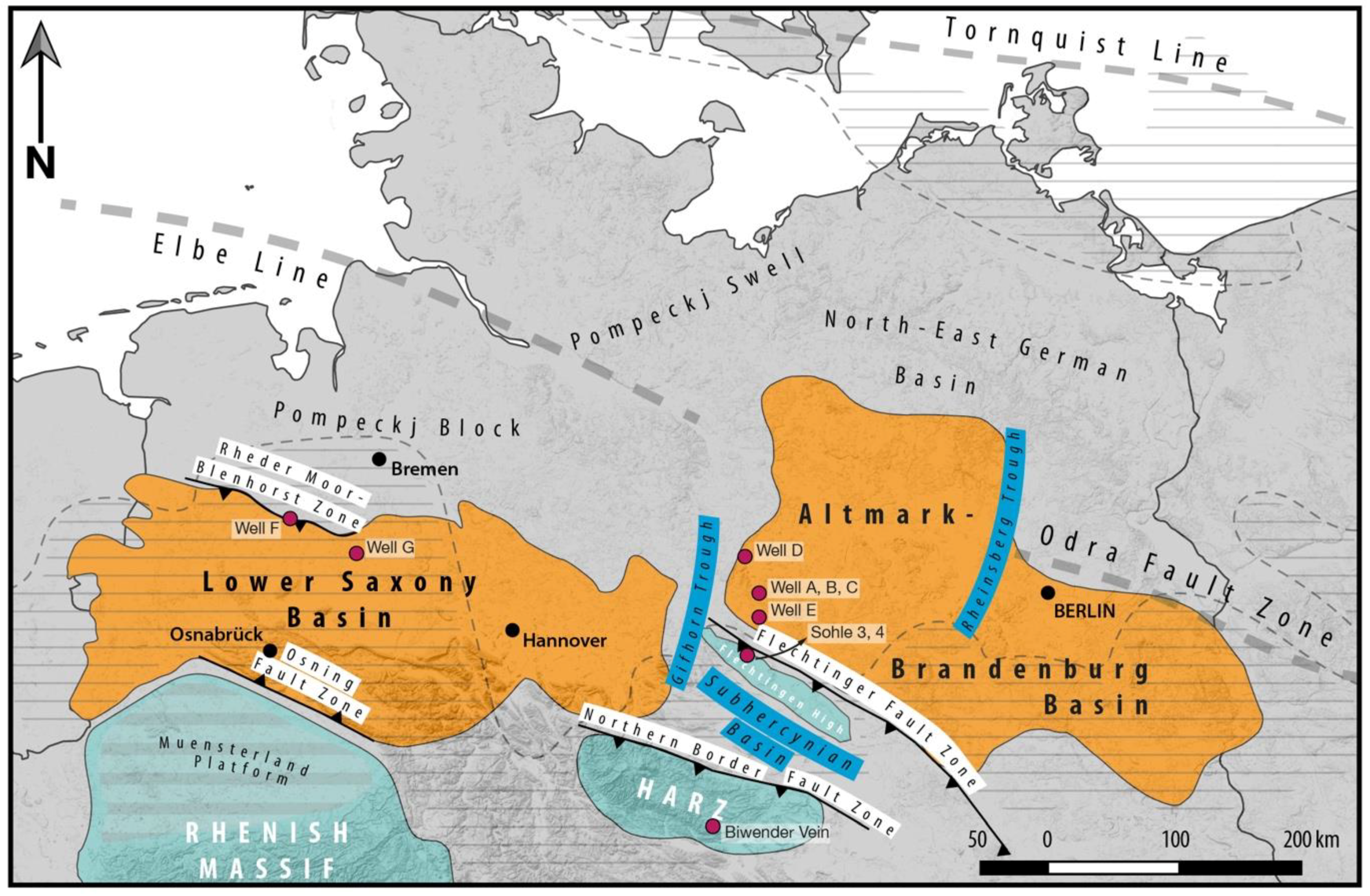
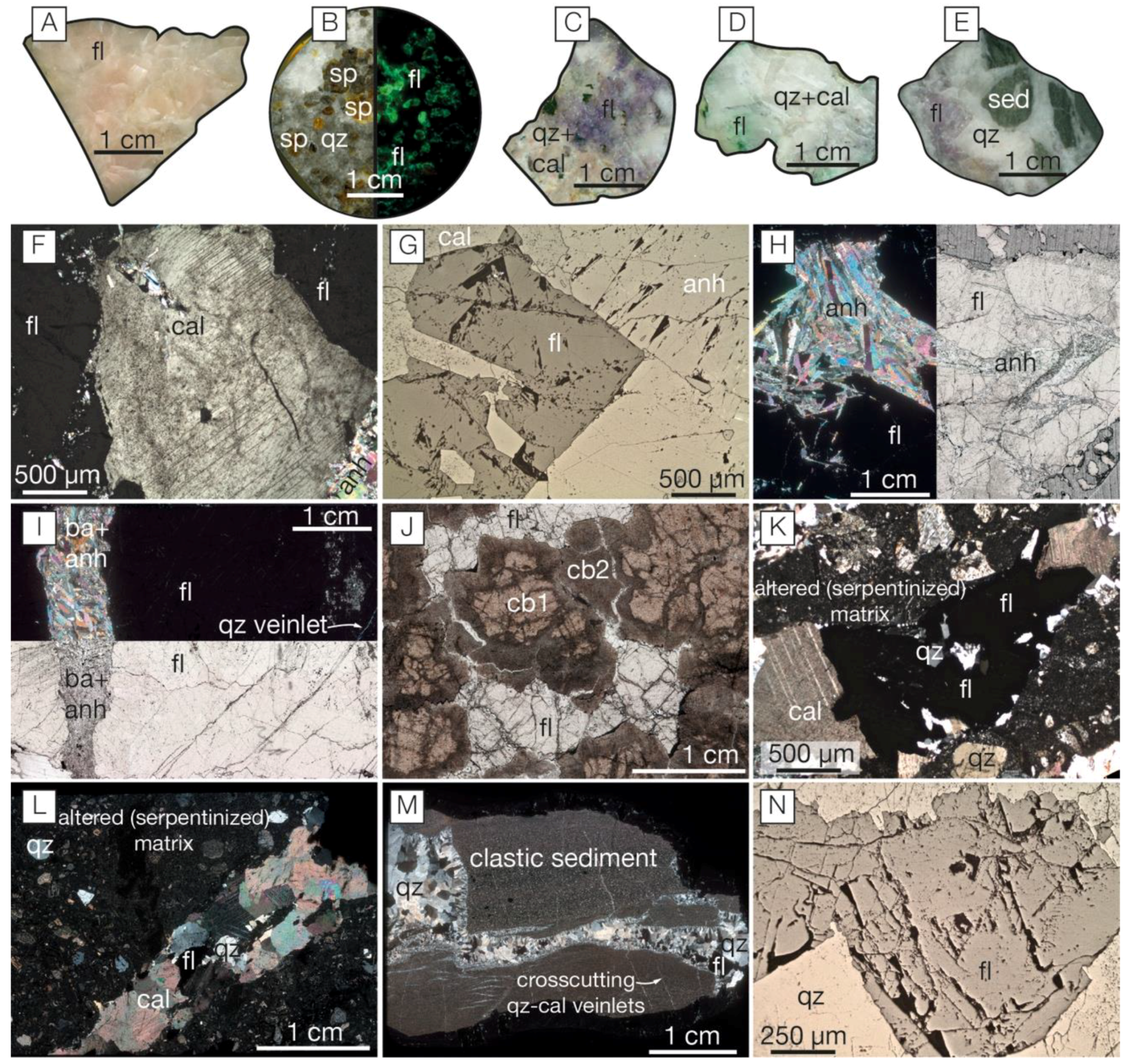
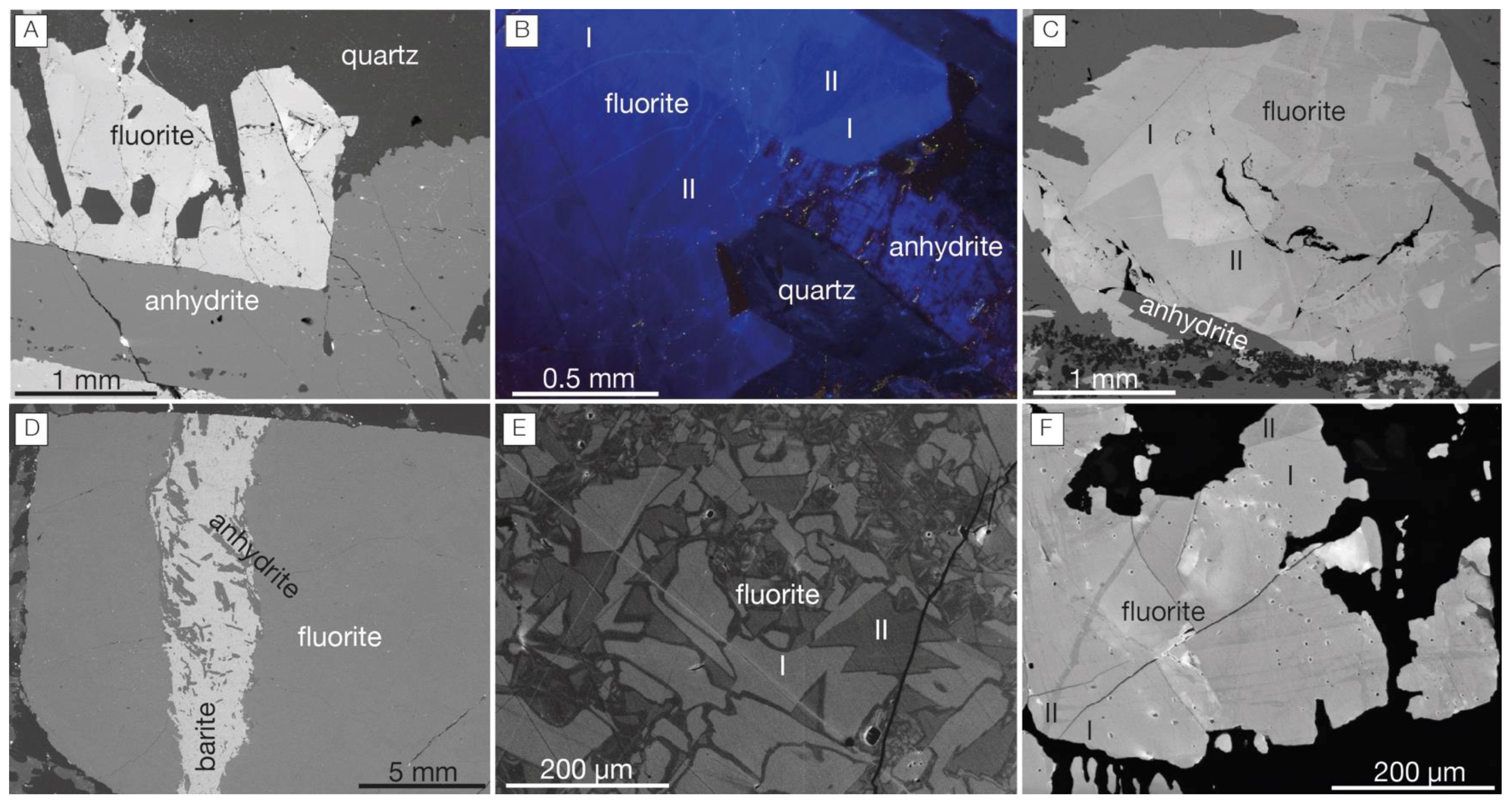
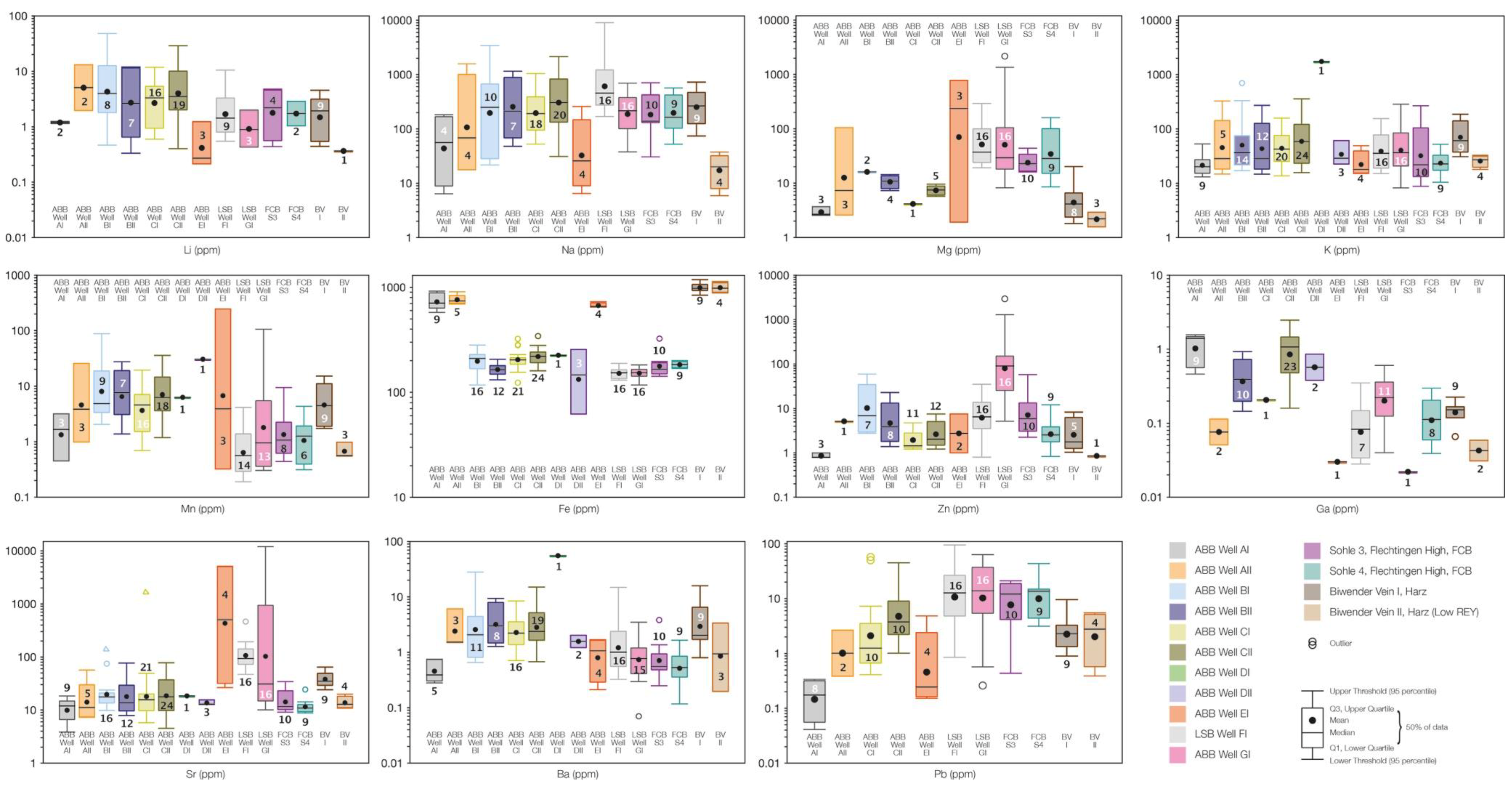
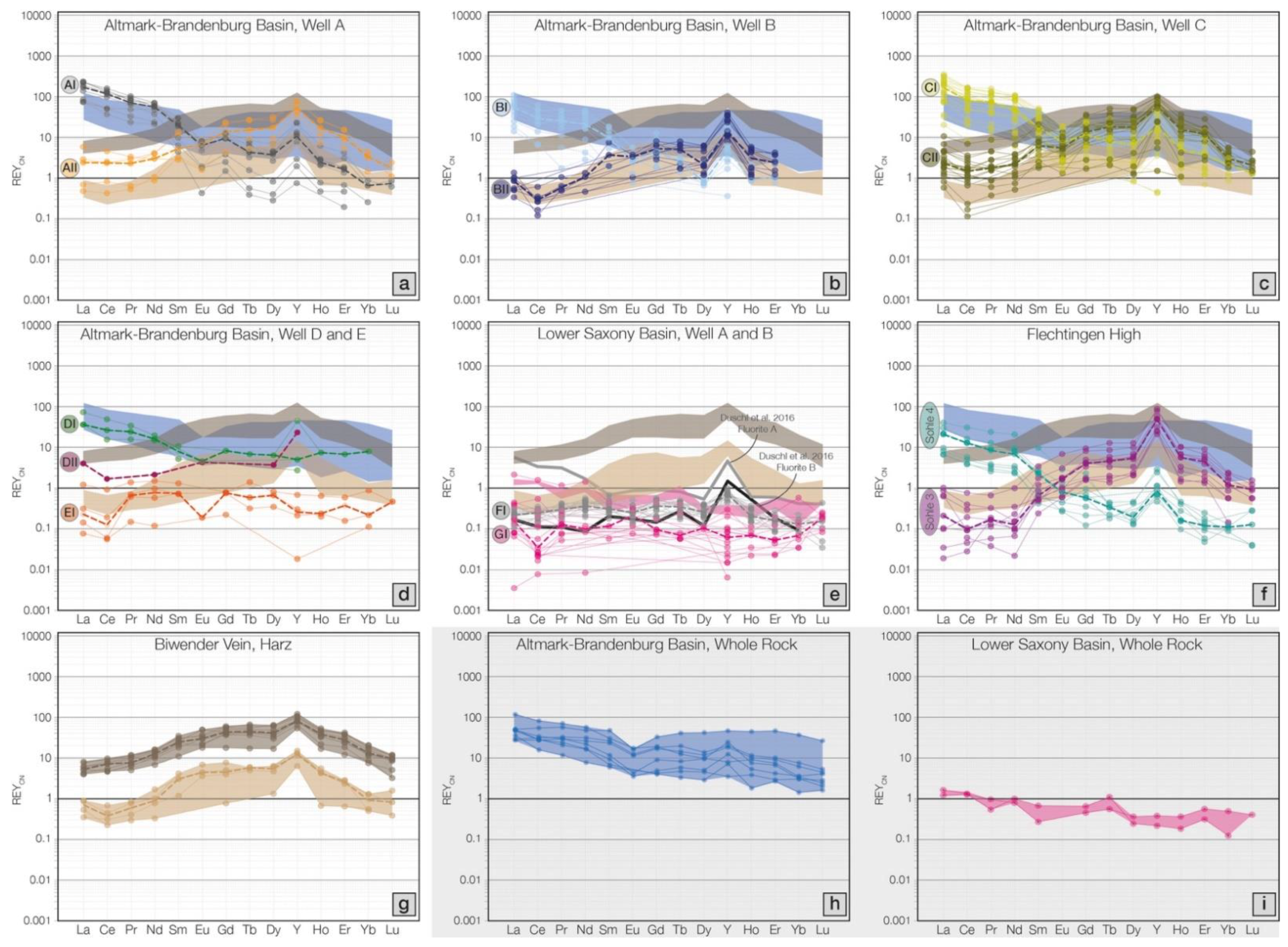
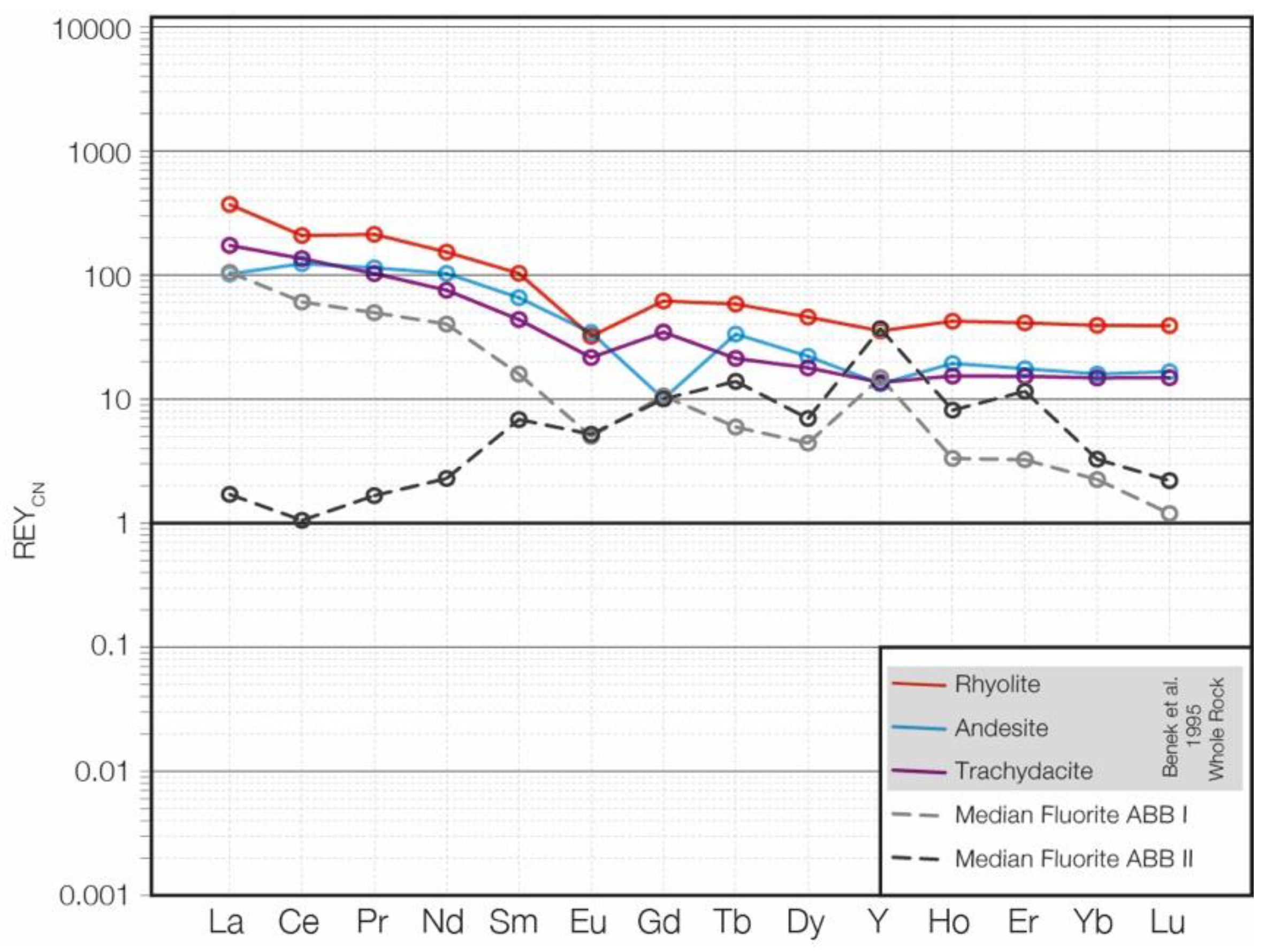
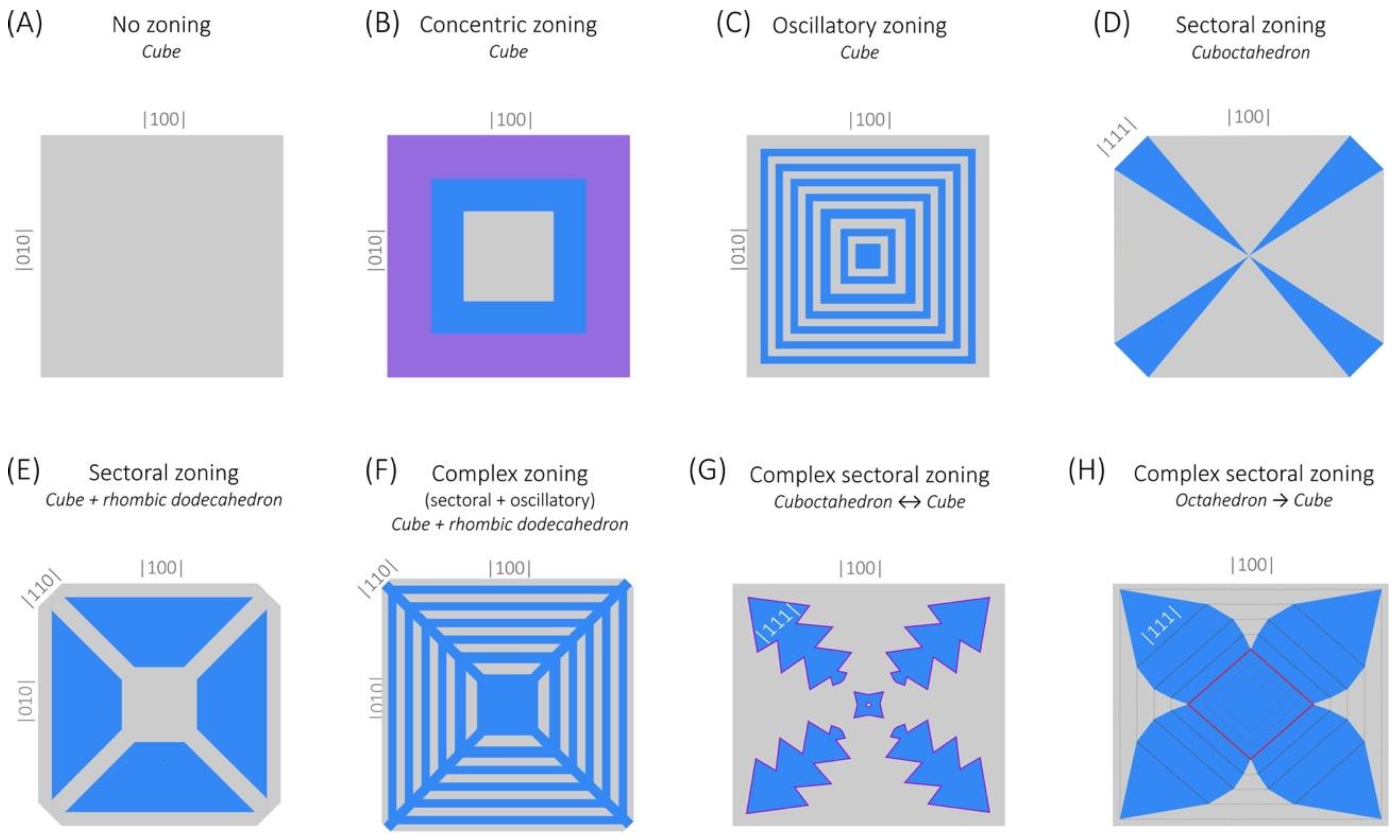
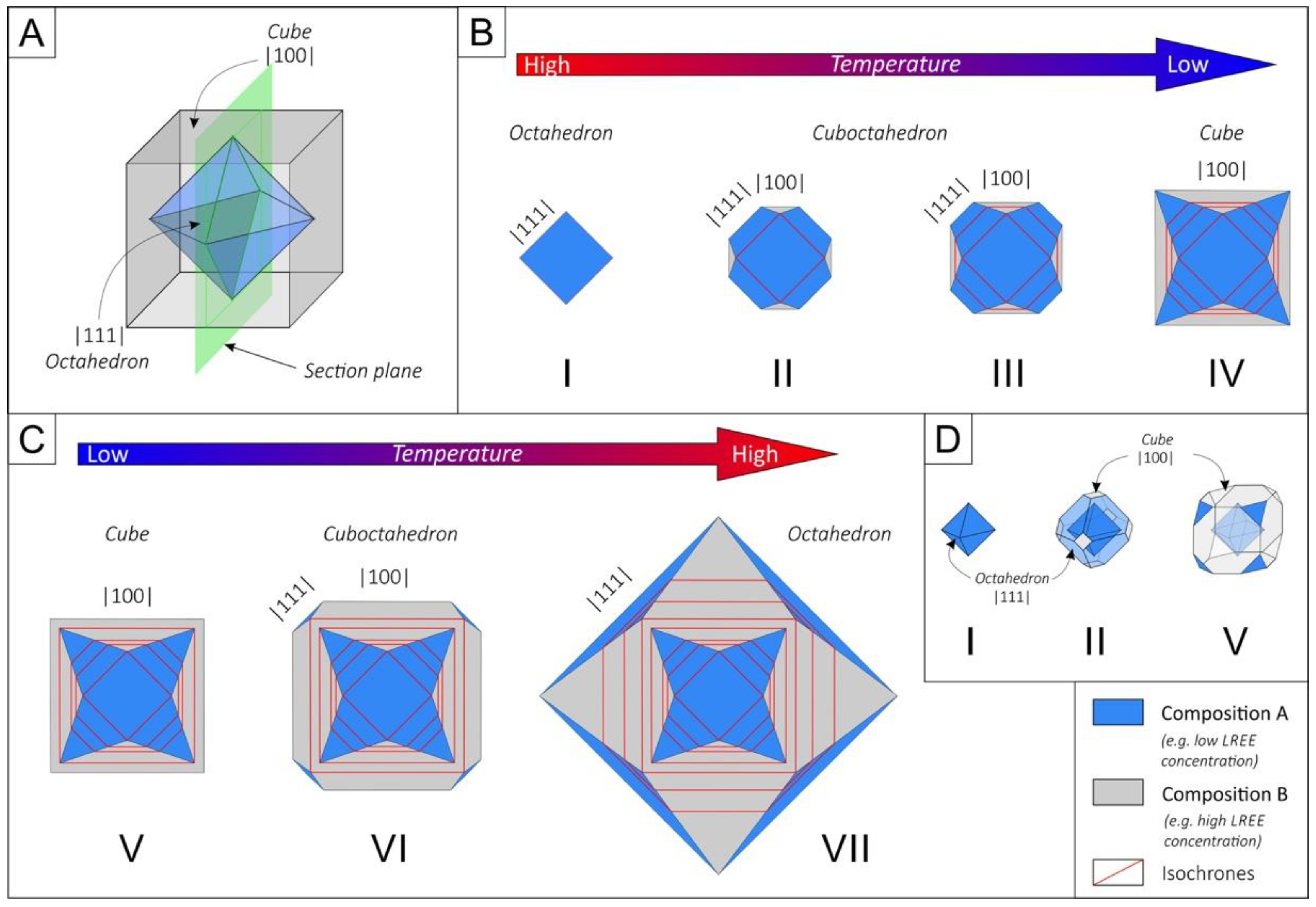

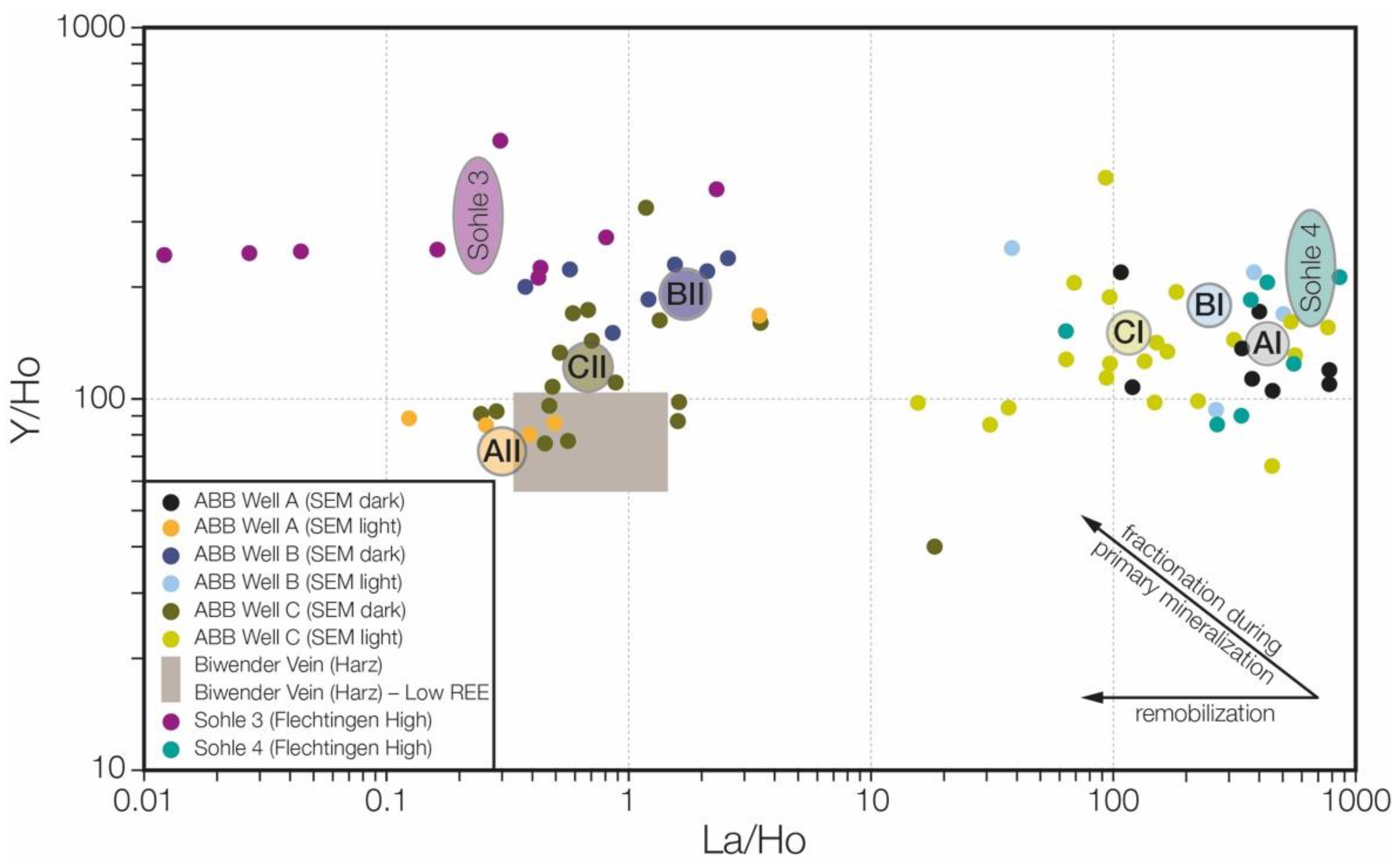
| Process Time | 6 µs |
|---|---|
| Channels | 2K |
| Energy spectrum | 0–10 keV |
| Detector | BSE and CL mode |
| Accelerating voltage | 15 kV |
| Working distance | 13–15 mm 14.6 mm (optimum conditions) |
| Sample current | 300–500 pA |
| ID and (#) | Stats | Li | Na | Mg | K | Mn | Fe | Zn | Ga | Sr | Ba | Pb |
|---|---|---|---|---|---|---|---|---|---|---|---|---|
| ABB Well AI (9) | Null | 7 | 5 | 6 | 0 | 6 | 0 | 6 | 0 | 0 | 4 | 1 |
| Min | 1.14 | 6.4 | 2.56 | 13.1 | 0.45 | 577 | 0.79 | 0.46 | 3.85 | 0.28 | 0.041 | |
| Max | 1.25 | 183 | 3.69 | 53.0 | 3.19 | 919 | 1 | 1.56 | 18.4 | 0.75 | 0.337 | |
| Median | 1.19 | 77.8 | 2.67 | 20.2 | 1.67 | 707 | 0.79 | 1.4 | 12.0 | 0.39 | 0.177 | |
| ABB Well AII (5) | Null | 3 | 1 | 2 | 0 | 2 | 0 | 4 | 3 | 0 | 2 | 3 |
| Min | 1.97 | 17.7 | 2.59 | 14.8 | 0.99 | 693 | 5.13 | 0.051 | 7.29 | 1.5 | 0.385 | |
| Max | 13.1 | 1583 | 106 | 327 | 25.7 | 907 | 5.13 | 0.114 | 56.6 | 6.1 | 2.66 | |
| Median | 7.56 | 140 | 7.32 | 28.4 | 3.86 | 741 | 5.13 | 0.082 | 11.17 | 1.53 | 1.52 | |
| ABB Well BI (16) | Null | 8 | 6 | 14 | 2 | 7 | 0 | 9 | 16 | 0 | 5 | 16 |
| Min | 0.47 | 21.7 | 16 | 17.1 | 2.06 | 117 | 2.76 | — | 9.83 | 0.66 | — | |
| Max | 48.3 | 3424 | 16.2 | 698 | 87.9 | 281 | 59.1 | — | 140 | 28 | — | |
| Median | 4.03 | 253 | 16.1 | 38.6 | 4.87 | 210 | 6.89 | — | 17.7 | 2.07 | — | |
| ABB Well BII (12) | Null | 5 | 5 | 8 | 0 | 5 | 0 | 4 | 2 | 0 | 4 | 12 |
| Min | 0.333 | 48 | 7.31 | 14.7 | 1.38 | 131 | 1.39 | 0.145 | 7.9 | 1.27 | — | |
| Max | 12 | 1153 | 14.4 | 271 | 27.5 | 206 | 22.8 | 0.925 | 77.1 | 9.37 | — | |
| Median | 2.65 | 212 | 10.9 | 28.7 | 7.67 | 164 | 3.91 | 0.392 | 13.8 | 2.99 | — | |
| ABB Well CI (21) | Null | 5 | 3 | 20 | 1 | 5 | 0 | 10 | 20 | 0 | 5 | 11 |
| Min | 0.60 | 52.6 | 4.14 | 13.7 | 0.69 | 123 | 1.21 | 0.207 | 5.79 | 0.708 | 0.41 | |
| Max | 11.9 | 1045 | 4.14 | 158 | 19.4 | 323 | 4.74 | 0.207 | 1676 | 8.43 | 57.4 | |
| Median | 3.33 | 192 | 4.14 | 42.55 | 4.70 | 203 | 1.44 | 0.207 | 15.6 | 2.22 | 1.26 | |
| ABB Well CII (24) | Null | 5 | 4 | 19 | 0 | 6 | 0 | 12 | 1 | 0 | 5 | 14 |
| Min | 0.403 | 31.1 | 5.71 | 15.7 | 1.19 | 160 | 1.21 | 0.16 | 4.53 | 0.677 | 1.01 | |
| Max | 29 | 2142 | 9.58 | 357 | 35.7 | 343 | 7.5 | 2.47 | 77.9 | 15 | 44.9 | |
| Median | 3.52 | 310 | 7.49 | 58.7 | 6.33 | 219.5 | 2.04 | 1.07 | 17.9 | 2.38 | 3.83 | |
| ABB Well DI (1) | Null | 1 | 1 | 1 | 0 | 0 | 0 | 1 | 1 | 0 | 0 | 1 |
| Min | — | — | — | 1743 | 6.33 | 225 | — | — | 18.5 | 55.4 | — | |
| Max | — | — | — | 1743 | 6.33 | 225 | — | — | 18.5 | 55.4 | — | |
| Median | — | — | — | 1743 | 6.33 | 225 | — | — | 18.5 | 55.4 | — | |
| ABB Well DII (3) | Null | 3 | 3 | 3 | 0 | 2 | 0 | 3 | 1 | 0 | 1 | 3 |
| Min | — | — | — | 22.6 | 30.5 | 62.3 | — | 0.378 | 12.7 | 1.22 | — | |
| Max | — | — | — | 61 | 30.5 | 256 | — | 0.854 | 15.5 | 2.03 | — | |
| Median | — | — | — | 28.9 | 30.5 | 146 | — | 0.616 | 12.9 | 1.625 | — | |
| ABB Well EI (4) | Null | 1 | 0 | 1 | 0 | 1 | 0 | 2 | 3 | 0 | 0 | 0 |
| Min | 0.214 | 6.5 | 1.91 | 15.17 | 0.322 | 647 | 1 | 0.03 | 26.6 | 0.211 | 0.152 | |
| Max | 1.24 | 258 | 776 | 49.2 | 245 | 729 | 7.55 | 0.03 | 5134 | 1.69 | 4.81 | |
| Median | 0.271 | 25.9 | 235 | 18.1 | 3.92 | 657 | 4.28 | 0.03 | 504 | 1.13 | 0.249 | |
| LSB Well FI | Null | 7 | 0 | 0 | 0 | 2 | 0 | 0 | 9 | 0 | 0 | 0 |
| Min | 0.55 | 169 | 19.1 | 15.1 | 0.19 | 130 | 0.8 | 0.028 | 47.1 | 0.325 | 0.85 | |
| Max | 10.5 | 9032 | 292 | 155 | 4.18 | 188 | 34.7 | 0.348 | 465 | 14.9 | 95.2 | |
| Median | 1.43 | 469 | 37.3 | 36.5 | 0.562 | 153 | 6.53 | 0.083 | 93.4 | 1.01 | 12.75 | |
| LSB Well GI | Null | 13 | 0 | 0 | 0 | 3 | 0 | 0 | 5 | 0 | 1 | 0 |
| Min | 0.43 | 37.9 | 8.2 | 8.22 | 0.304 | 117 | 5.17 | 0.04 | 10.1 | 0.07 | 0.26 | |
| Max | 2 | 696 | 2170 | 285 | 106 | 182 | 2935 | 0.602 | 12000 | 3.49 | 63.4 | |
| Median | 0.89 | 216 | 29.2 | 37.3 | 0.95 | 154 | 90.8 | 0.223 | 31.2 | 0.77 | 14.0 | |
| Sohle 3, Flechtingen High | Null | 6 | 0 | 0 | 0 | 2 | 0 | 0 | 9 | 0 | 0 | 0 |
| Min | 0.44 | 30.6 | 16 | 8.77 | 0.44 | 142 | 2.25 | 0.022 | 9.15 | 0.249 | 0.436 | |
| Max | 4.78 | 708 | 43.8 | 267 | 9.43 | 324 | 57.3 | 0.022 | 34.3 | 3.82 | 21.1 | |
| Median | 2.63 | 139 | 22.9 | 22.3 | 1.07 | 165 | 5.99 | 0.022 | 11.7 | 0.554 | 12.1 | |
| Sohle 4, Flechtingen High | Null | 7 | 0 | 0 | 0 | 3 | 0 | 0 | 1 | 0 | 0 | 0 |
| Min | 1.04 | 52.3 | 8.53 | 10.4 | 0.313 | 168 | 0.83 | 0.039 | 8.78 | 0.117 | 3.13 | |
| Max | 2.88 | 569 | 161 | 52.3 | 4.35 | 200 | 12.11 | 0.296 | 24.4 | 1.65 | 43.6 | |
| Median | 1.96 | 164 | 28.3 | 22.7 | 1.275 | 183 | 2.53 | 0.112 | 10.8 | 0.53 | 13.6 | |
| Biwender Vein I, Harz | Null | 0 | 0 | 1 | 0 | 0 | 0 | 4 | 0 | 0 | 0 | 0 |
| Min | 0.444 | 74.2 | 1.8 | 30.9 | 1.74 | 841 | 1.03 | 0.066 | 24.1 | 0.8 | 0.895 | |
| Max | 4.56 | 728 | 20.2 | 186 | 15.2 | 1184 | 8.28 | 0.226 | 64.5 | 15.9 | 9.59 | |
| Median | 1.94 | 265 | 4.17 | 60.7 | 4.49 | 978 | 1.77 | 0.152 | 34.9 | 2.03 | 2.3 | |
| Biwender Vein II, Harz | Null | 3 | 0 | 1 | 0 | 1 | 0 | 3 | 2 | 0 | 1 | 0 |
| Min | 0.366 | 5.92 | 1.57 | 18.0 | 0.55 | 884 | 0.85 | 0.031 | 10.8 | 0.197 | 0.389 | |
| Max | 0.366 | 37.4 | 2.91 | 32.8 | 0.98 | 1135 | 0.85 | 0.059 | 19.9 | 3.37 | 5.51 | |
| Median | 0.366 | 20.1 | 2.21 | 27.1 | 0.564 | 984 | 0.85 | 0.045 | 12.8 | 0.94 | 3.03 |
| ID and (#) | Stats | La | Ce | Pr | Nd | Sm | Eu | Gd | Tb | Dy | Y | Ho | Er | Tm | Yb | Lu |
|---|---|---|---|---|---|---|---|---|---|---|---|---|---|---|---|---|
| ABB Well AI (9) | Null | 0 | 0 | 0 | 0 | 0 | 0 | 0 | 0 | 0 | 0 | 1 | 0 | 2 | 6 | 7 |
| Min | 17.3 | 22.27 | 2.17 | 9.59 | 0.646 | 0.024 | 0.295 | 0.014 | 0.069 | 1.17 | 0.0255 | 0.031 | 0.005 | 0.041 | 0.015 | |
| Max | 55.4 | 96.96 | 9.43 | 32.2 | 4.5 | 0.459 | 2.56 | 0.3 | 1.68 | 35.9 | 0.334 | 0.655 | 0.049 | 0.14 | 0.0212 | |
| Median | 40.1 | 71.46 | 6.51 | 25.2 | 2.88 | 0.354 | 1.88 | 0.153 | 0.91 | 16.8 | 0.132 | 0.261 | 0.0262 | 0.104 | 0.0181 | |
| ABB Well AII (5) | Null | 0 | 0 | 0 | 0 | 0 | 0 | 0 | 0 | 0 | 0 | 0 | 0 | 1 | 1 | 3 |
| Min | 0.113 | 0.259 | 0.049 | 0.4 | 0.413 | 0.09 | 0.85 | 0.188 | 1.62 | 53.8 | 0.399 | 0.873 | 0.0533 | 0.232 | 0.027 | |
| Max | 1.38 | 2.78 | 0.307 | 1.85 | 1.96 | 0.486 | 4.67 | 0.97 | 7.69 | 119 | 1.46 | 2.45 | 0.229 | 0.72 | 0.059 | |
| Median | 0.568 | 1.43 | 0.211 | 1.36 | 0.77 | 0.374 | 2.72 | 0.542 | 4.21 | 80.8 | 0.912 | 1.61 | 0.178 | 0.539 | 0.043 | |
| ABB Well BI (16) | Null | 7 | 8 | 12 | 13 | 13 | 13 | 10 | 8 | 2 | 0 | 4 | 8 | 14 | 16 | 16 |
| Min | 0.082 | 0.076 | 0.046 | 0.216 | 0.298 | 0.06 | 0.577 | 0.063 | 0.296 | 12.6 | 0.059 | 0.172 | 0.049 | — | — | |
| Max | 0.328 | 0.382 | 0.1 | 0.624 | 1.13 | 0.215 | 1.63 | 0.292 | 1.58 | 65.3 | 0.326 | 0.688 | 0.06 | — | — | |
| Median | 0.206 | 0.182 | 0.0555 | 0.498 | 0.556 | 0.191 | 1.055 | 0.185 | 0.533 | 22.85 | 0.17 | 0.392 | 0.0545 | — | — | |
| ABB Well BII (12) | Null | 1 | 1 | 1 | 1 | 3 | 2 | 4 | 6 | 5 | 0 | 8 | 9 | 12 | 12 | 12 |
| Min | 3.39 | 3.94 | 0.166 | 1.32 | 0.294 | 0.044 | 0.365 | 0.052 | 0.163 | 0.58 | 0.047 | 0.125 | — | — | — | |
| Max | 26.2 | 38.2 | 4.26 | 21.3 | 2.79 | 0.331 | 2.58 | 0.121 | 0.61 | 29.8 | 0.117 | 0.349 | — | — | — | |
| Median | 13 | 18 | 2.36 | 9.73 | 1.46 | 0.158 | 0.876 | 0.0955 | 0.201 | 8.05 | 0.0505 | 0.172 | — | — | — | |
| ABB Well CI (21) | Null | 3 | 1 | 5 | 5 | 7 | 6 | 4 | 4 | 2 | 0 | 3 | 4 | 5 | 6 | 13 |
| Min | 0.139 | 0.071 | 0.035 | 0.238 | 0.262 | 0.075 | 0.337 | 0.075 | 0.303 | 2.36 | 0.059 | 0.439 | 0.04 | 0.293 | 0.033 | |
| Max | 2.5 | 4.24 | 0.805 | 4.3 | 3.09 | 0.75 | 7.15 | 1.82 | 12.1 | 152 | 1.96 | 4.45 | 0.266 | 0.919 | 0.108 | |
| Median | 0.544 | 0.908 | 0.164 | 1.005 | 0.916 | 0.304 | 2.67 | 0.644 | 4.36 | 88 | 0.843 | 1.92 | 0.188 | 0.487 | 0.051 | |
| ABB Well CII (24) | Null | 0 | 0 | 0 | 0 | 2 | 4 | 3 | 4 | 3 | 0 | 4 | 5 | 14 | 15 | 22 |
| Min | 4.74 | 5.17 | 0.771 | 2.69 | 0.328 | 0.079 | 0.403 | 0.072 | 0.199 | 0.679 | 0.051 | 0.111 | 0.039 | 0.14 | 0.03 | |
| Max | 81.4 | 102 | 14.4 | 49.3 | 7.57 | 1.06 | 5.39 | 1.06 | 6.11 | 120 | 1.23 | 2.34 | 0.179 | 0.54 | 0.035 | |
| Median | 38.6 | 48.1 | 6.72 | 21.05 | 2.59 | 0.428 | 2.26 | 0.283 | 1.57 | 27.75 | 0.275 | 0.602 | 0.091 | 0.34 | 0.0325 | |
| ABB Well DI (1) | Null | 0 | 0 | 1 | 0 | 1 | 0 | 1 | 1 | 0 | 0 | 1 | 1 | 1 | 1 | 1 |
| Min | 0.954 | 1.03 | — | 0.971 | — | 0.241 | — | — | 0.908 | 36.6 | — | — | — | — | — | |
| Max | 0.954 | 1.03 | — | 0.971 | — | 0.241 | — | — | 0.908 | 36.6 | — | — | — | — | — | |
| Median | 0.954 | 1.03 | — | 0.971 | — | 0.241 | — | — | 0.908 | 36.6 | — | — | — | — | — | |
| ABB Well DII (3) | Null | 0 | 0 | 0 | 0 | 1 | 2 | 2 | 2 | 2 | 0 | 2 | 2 | 3 | 2 | 3 |
| Min | 8.56 | 9.53 | 1.46 | 6.67 | 0.768 | 0.256 | 1.64 | 0.246 | 1.57 | 4.28 | 0.405 | 1.08 | — | 1.28 | — | |
| Max | 17.4 | 29.9 | 3.16 | 8.98 | 1.59 | 0.256 | 1.64 | 0.246 | 1.57 | 69.8 | 0.405 | 1.08 | — | 1.28 | — | |
| Median | 8.59 | 16.2 | 2.24 | 7.33 | 1.179 | 0.256 | 1.64 | 0.246 | 1.57 | 7.83 | 0.405 | 1.08 | — | 1.28 | — | |
| ABB Well EI (4) | Null | 0 | 0 | 0 | 0 | 1 | 3 | 0 | 1 | 1 | 0 | 1 | 2 | 2 | 1 | 3 |
| Min | 0.018 | 0.0338 | 0.0137 | 0.054 | 0.104 | 0.0105 | 0.044 | 0.0114 | 0.085 | 0.029 | 0.0109 | 0.025 | 0.0054 | 0.018 | 0.0114 | |
| Max | 0.287 | 0.565 | 0.128 | 0.685 | 0.193 | 0.0105 | 0.159 | 0.0503 | 0.201 | 1.068 | 0.0348 | 0.094 | 0.0076 | 0.14 | 0.0114 | |
| Median | 0.0539 | 0.0767 | 0.0607 | 0.353 | 0.109 | 0.0105 | 0.15 | 0.021 | 0.163 | 0.4025 | 0.0129 | 0.0595 | 0.0065 | 0.035 | 0.0114 | |
| LSB Well FI (16) | Null | 0 | 0 | 0 | 0 | 2 | 0 | 1 | 2 | 0 | 0 | 3 | 2 | 6 | 9 | 9 |
| Min | 0.0237 | 0.087 | 0.0167 | 0.088 | 0.026 | 0.0072 | 0.036 | 0.0061 | 0.032 | 0.678 | 0.0077 | 0.013 | 9.60E-04 | 0.0125 | 0.0008 | |
| Max | 0.081 | 0.213 | 0.0386 | 0.254 | 0.1 | 0.0282 | 0.112 | 0.018 | 0.099 | 1.544 | 0.02 | 0.044 | 0.013 | 0.035 | 0.0105 | |
| Median | 0.0514 | 0.151 | 0.0272 | 0.163 | 0.045 | 0.014 | 0.071 | 0.0123 | 0.0625 | 1.1125 | 0.011 | 0.025 | 0.00515 | 0.021 | 0.0037 | |
| LSB Well GI (16) | Null | 4 | 1 | 6 | 12 | 13 | 12 | 10 | 10 | 14 | 1 | 11 | 9 | 10 | 9 | 9 |
| Min | 0.0008 | 0.0047 | 0.0048 | 0.0038 | 0.0083 | 0.0042 | 0.014 | 0.002 | 0.024 | 0.01 | 0.0012 | 0.0036 | 0.0018 | 0.0055 | 0.002 | |
| Max | 0.501 | 0.956 | 0.107 | 0.643 | 0.065 | 0.018 | 0.087 | 0.014 | 0.027 | 0.461 | 0.006 | 0.031 | 0.0083 | 0.092 | 0.0062 | |
| Median | 0.0356 | 0.0213 | 0.0118 | 0.045 | 0.017 | 0.0118 | 0.019 | 0.00245 | 0.0255 | 0.095 | 0.0037 | 0.0083 | 0.00485 | 0.0108 | 0.0045 | |
| Sohle 3, Flechtingen High (10) | Null | 1 | 0 | 1 | 0 | 1 | 0 | 0 | 0 | 0 | 0 | 0 | 0 | 1 | 0 | 4 |
| Min | 0.0045 | 0.0172 | 0.0035 | 0.01 | 0.035 | 0.0325 | 0.308 | 0.049 | 0.496 | 32.7 | 0.078 | 0.211 | 0.0193 | 0.023 | 0.0135 | |
| Max | 0.239 | 0.462 | 0.0606 | 0.451 | 0.502 | 0.384 | 1.87 | 0.458 | 3.12 | 138 | 0.555 | 1.43 | 0.097 | 0.383 | 0.0377 | |
| Median | 0.0493 | 0.0598 | 0.0153 | 0.0575 | 0.095 | 0.0915 | 0.789 | 0.164 | 1.30 | 75.6 | 0.303 | 0.701 | 0.0494 | 0.19 | 0.0226 | |
| Sohle 4, Flechtingen High (9) | Null | 0 | 0 | 0 | 0 | 0 | 1 | 0 | 3 | 3 | 0 | 2 | 1 | 5 | 5 | 4 |
| Min | 1.53 | 2.321 | 0.236 | 1.037 | 0.061 | 0.0148 | 0.024 | 0.0064 | 0.031 | 0.725 | 0.0052 | 0.0076 | 0.00094 | 0.014 | 0.00094 | |
| Max | 9.46 | 18.7 | 2.2 | 9.39 | 1.43 | 0.159 | 0.45 | 0.0159 | 0.112 | 4.51 | 0.0249 | 0.039 | 0.0045 | 0.021 | 0.0069 | |
| Median | 4.89 | 7.78 | 0.775 | 3.09 | 0.32 | 0.0444 | 0.114 | 0.012 | 0.047 | 1.342 | 0.0088 | 0.0188 | 0.00375 | 0.0175 | 0.0031 | |
| Biwender Vein I, Harz (9) | Null | 0 | 0 | 0 | 0 | 0 | 0 | 0 | 0 | 0 | 0 | 0 | 0 | 0 | 0 | 0 |
| Min | 0.955 | 2.84 | 0.468 | 3.11 | 1.63 | 1.01 | 3.55 | 0.621 | 4.15 | 83.9 | 0.919 | 1.94 | 0.226 | 1.21 | 0.08 | |
| Max | 1.94 | 6.03 | 1.11 | 7.45 | 5.16 | 2.78 | 12.02 | 2.401 | 15.87 | 188.8 | 2.9 | 6.71 | 0.702 | 3.35 | 0.297 | |
| Median | 1.26 | 4.38 | 0.715 | 5.82 | 3.65 | 1.69 | 8.64 | 1.612 | 10.12 | 128 | 2.064 | 4.47 | 0.463 | 2.14 | 0.237 | |
| Biwender Vein II, Harz (4) | Null | 0 | 0 | 0 | 0 | 1 | 1 | 0 | 1 | 0 | 0 | 0 | 0 | 0 | 0 | 1 |
| Min | 0.084 | 0.14 | 0.0277 | 0.152 | 0.177 | 0.204 | 0.155 | 0.18 | 0.329 | 9.95 | 0.037 | 0.104 | 0.023 | 0.082 | 0.0096 | |
| Max | 0.215 | 0.423 | 0.08 | 0.783 | 0.618 | 0.389 | 1.54 | 0.216 | 1.56 | 23.7 | 0.304 | 0.459 | 0.05 | 0.211 | 0.0394 | |
| Median | 0.168 | 0.234 | 0.0557 | 0.413 | 0.455 | 0.252 | 0.9 | 0.209 | 1.345 | 19.7 | 0.236 | 0.415 | 0.0454 | 0.151 | 0.0204 |
© 2018 by the authors. Licensee MDPI, Basel, Switzerland. This article is an open access article distributed under the terms and conditions of the Creative Commons Attribution (CC BY) license (http://creativecommons.org/licenses/by/4.0/).
Share and Cite
Nadoll, P.; Rehm, M.; Duschl, F.; Klemd, R.; Kraemer, D.; Sośnicka, M. REY and Trace Element Chemistry of Fluorite from Post-Variscan Hydrothermal Veins in Paleozoic Units of the North German Basin. Geosciences 2018, 8, 283. https://doi.org/10.3390/geosciences8080283
Nadoll P, Rehm M, Duschl F, Klemd R, Kraemer D, Sośnicka M. REY and Trace Element Chemistry of Fluorite from Post-Variscan Hydrothermal Veins in Paleozoic Units of the North German Basin. Geosciences. 2018; 8(8):283. https://doi.org/10.3390/geosciences8080283
Chicago/Turabian StyleNadoll, Patrick, Meike Rehm, Florian Duschl, Reiner Klemd, Dennis Kraemer, and Marta Sośnicka. 2018. "REY and Trace Element Chemistry of Fluorite from Post-Variscan Hydrothermal Veins in Paleozoic Units of the North German Basin" Geosciences 8, no. 8: 283. https://doi.org/10.3390/geosciences8080283
APA StyleNadoll, P., Rehm, M., Duschl, F., Klemd, R., Kraemer, D., & Sośnicka, M. (2018). REY and Trace Element Chemistry of Fluorite from Post-Variscan Hydrothermal Veins in Paleozoic Units of the North German Basin. Geosciences, 8(8), 283. https://doi.org/10.3390/geosciences8080283





